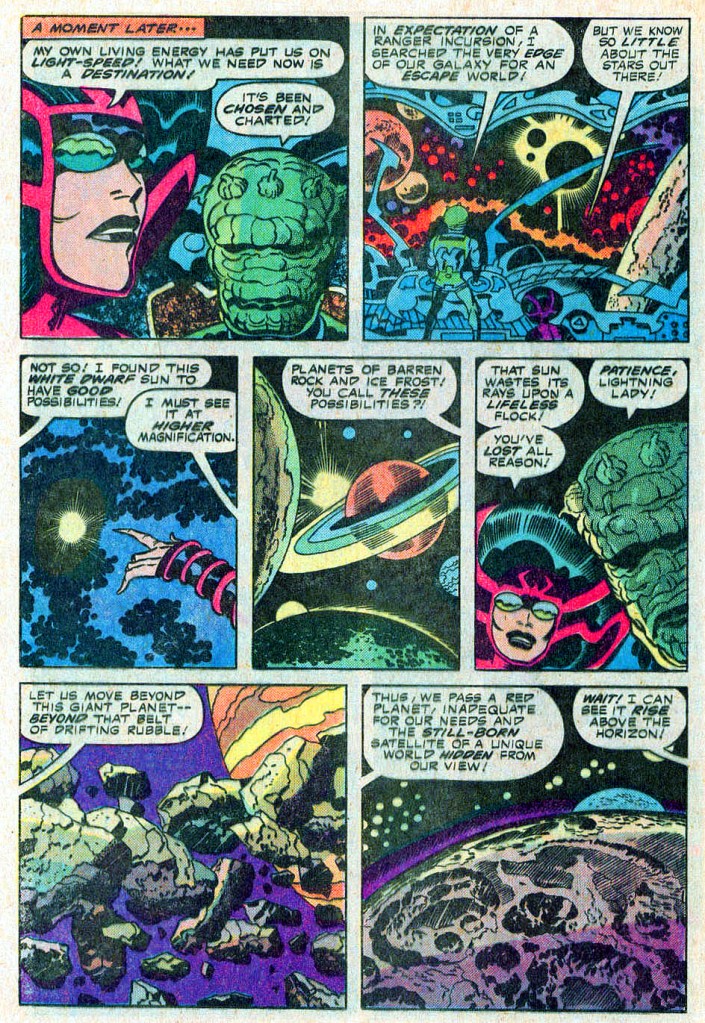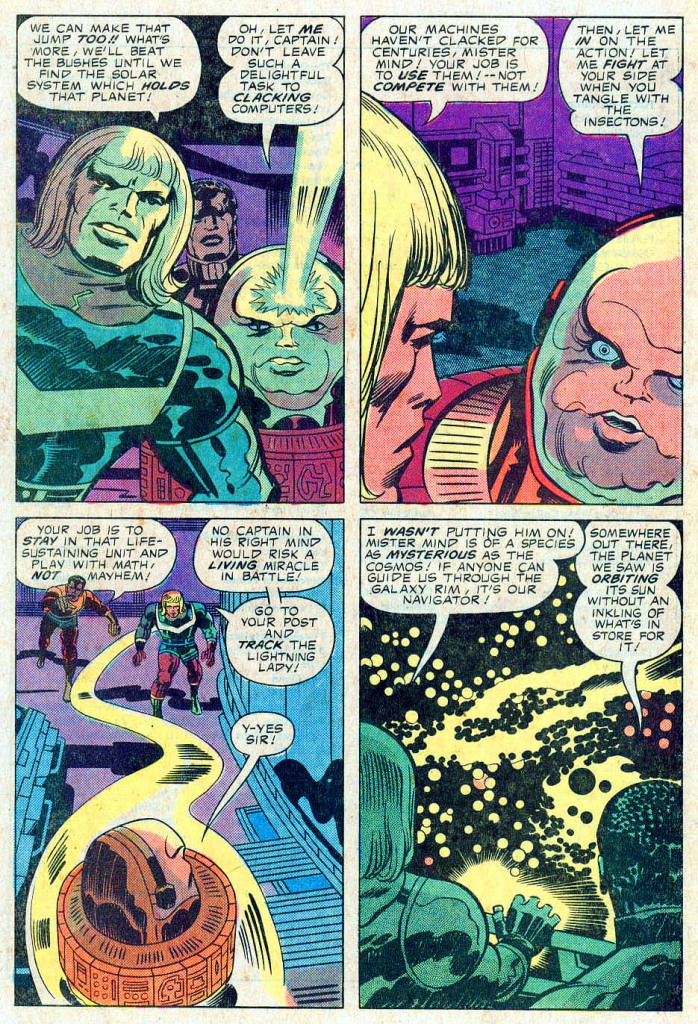
By the very beginning of the 1980s, what we now know as the Direct Market for comic books–specialty shops devoted to the product who would buy new issues on a non-returnable basis, thus eliminating the enormous amount of waste the Newsstand consignment system generated–had grown to the point where it looked as though there might be enough accounts to generate sufficient orders to make titles directed exclusively at the Direct Market possible. And there was a bit of a gold rush, as new companies sprouted up attempting to tap into this new marketplace, while mainstays Marvel and DC tried to work out how to leverage it to best advantage.

One of the earliest entrants into this burgeoning marketplace was Pacific Comics, owned by the Schanes brothers. They had been distributors for comics into the Direct Market, and they saw an opportunity to make the transition into publishers themselves. Theirs was among the earliest product directed at the Comic Book Specialty Shops whose package mirrored that of Marvel and DC–most earlier trailblazers, such as WaRP Graphics or CEREBUS or THE FIRST KINGDOM or Eclipse tended to be publishing either in a magazine format or in black and white. But Pacific Comics would field comic books that looked and felt similar to those of the major publishers.

Pacific Comics didn’t last long, only a couple of years–they overextended themselves financially and after a few reversals they were forced to go out of business–competing firm Eclipse Comics wound up putting out a few of the last remaining unpublished Pacific Comics products. Still, in their brief time on the stands, they released new series by Mike Grell and Steve Ditko, created a new short-lived renaissance for horror with Bruce Jones’ TWISTED TALES, unleashed Dave Stevens’ The Rocketeer onto the world–and published some of the last original concepts created by the King of comics himself, Jack Kirby.

Upon embarking on their venture, the Schanes Brothers approached Kirby about contributing their initial offering. Kirby at this point had left the world of regular comics–he was employed in animation, where he was making better money and receiving health insurance. But one aspect of the Schaneses offer was intriguing to him: they intended to allow the creators of their books to retain ownership of the material . This was a necessary step for the industry and something that Kirby had been pushing to accomplish for years–it was this lack of creator ownership that saw him lose creative and financial control over the characters he had originated for both Marvel and DC over the years–characters that had gone on to generate millions of dollars in profits (and would thereafter generate billions more.)

Having a day job, and with Pacific Comics not yet possessing any sort of a track record, Kirby could ill afford to devote a lot of time to this venture. But as it turns out, he didn’t have to, not immediately at any rate. Because a few years earlier, he had been approached by backers for a similar venture: they wanted to fund a new company called Jack Kirby Comics, and while the deal had ultimately fallen through, Kirby had generated a decent amount of material for what would have been their launch title, CAPTAIN VICTORY AND THE GALACTIC RANGERS.

CAPTAIN VICTORY was inspired in part by the success of the movie CLOSE ENCOUNTERS OF THE THIRD KIND, which postulated that contact with beings from another world would lead to them benevolently welcoming humanity into the intergalactic community and sharing their wonderous technology with us. Kirby felt that this was fairy tale thinking. He knew from history that when two cultures come into contact with one another, the technologically superior of the two tends to wind up dominating and subjugating the lesser. So he thought that the message of CLOSE ENCOUNTERS was flawed, and intended to put forward his own rebuttal in the pages of CAPTAIN VICTORY.

As with much of his work in the 1970s, on the surface CAPTAIN VICTORY looked like a super hero series. But it wasn’t, not really. Nor was it, strictly speaking, science fiction, though it contained a liberal use of super-science and far-out technology. But really, when you looked under the hood, CAPTAIN VICTORY was really a war comic, depicting the struggle between the Galactic Rangers, sentinels of civilization throughout the cosmos, and their enemies the Insectons, who would infest a planet and consume it from within. Earth was the setting for this intergalactic war (much as it had been during Kirby’s NEW GODS saga) but the terms and the turf were interplanetary.

I can remember how exciting it was to have a new comic book company debuting when the initial promotion for CAPTAIN VICTORY AND THE GALACTIC RANGERS reached the public. The Pacific Comics titles cost more than either Marvel or DC–this first issue would set one back a whole dollar, as opposed to the 50 cents that most comics were retailing for. But the Schanes Brothers put more expense into their package as well. They printed on better paper (which would get even better as time went on) and used more expensive full process color as well. I do think that the color here, by Steve Oliff, is a bit garish and overpowering. But these were early days–Steve got a lot better at this as he went.

Because it had mostly been prepared earlier, this first issue of CAPTAIN VICTORY was inked and lettered by Mike Royer, Kirby’s inker of choice for most of the 1970s, who always rendered the King’s work faithfully and with precision. Later issues, though, didn’t benefit from Royer’s touch as he had a day job of his own that he needed to devote himself to. So the quality of the rendering diminished as the series went along, with less skilled inkers taking their brush to Kirby’s work.

Ultimately, CAPTAIN VICTORY was only a middle of the road success, and ended after 13 issues and a Special. But along the way, Kirby made the choice to link this series to his earlier NEW GODS mythology by implying that Captain Victory was himself the son of Orion of the New Gods. In this way, CAPTAIN VICTORY becomes the third act of a godly saga that beings in THOR in the 1960s, moves into NEW GODS in the 1970s, and then wraps up in CAPTAIN VICTORY in the early 1980s. One of the reasons that Kirby was able to get away with this, I expect, is that he did it so stealthily. There isn’t anything in the first 7 or 8 issues to suggest such a connection, so by the time he went for it, anybody who might have objected seems to have stopped paying attention.

CAPTAIN VICTORY was also one of the last projects Kirby worked on before health issues began to impact on his vision, and his work, always abstracted, began to distort in unflattering ways. Kirby kept much of his heath problems under wraps, fearful that he would lose his position in animation and by extension his health benefits. But it means that CAPTAIN VICTORY was one of the last major works produced by him.

(On a more personal note, I had a fan letter printed in the second issue of CAPTAIN VICTORY praising this initial outing. It was, I believe, the only fan letter I ever had published–and my name was misspelled, a common pitfall.)














Reading this entry, it makes me realize how little I know about the histories of the various comic companies past and present beyond the Big Two (and Image).
Does anybody have a good book recommendation that talks about these companies, the unique (or not so unique) product and practices they brought to the market, and the historical and economic backdrop they existed in? (I’ve already read Steranko, which is more a *part* of history than a record of it at this point).
LikeLiked by 1 person
Highly recommend the ‘Chronicles of American Comics’ books by TwoMorrows publishing – they generally cover one decade at a time (except for the sixties – which has two volumes because of the significance of that era). They are profusely illustrated and well-researched, without driving any particular ‘narrative’.
LikeLiked by 1 person
Good suggestion. Those books can be purchased through the TwoMorrows website…
https://twomorrows.com/
LikeLike
Thank you Roscoe!!!
LikeLike
The older I get, the more I appreciate some of Kirby’s more abstract drawings. As a young kid in the 70’s, I was repulsed by his Captain America run. And by the mid-80’s, my early teens, his health issues must have really impacted his “Super Powers” run at DC Comics. But “Captain Victory” comes off as solid stuff. I read an article in “Amazing Heroes” or somewhere else, that compared this series with the disposable nature of a capitalist workforce. As much of a stretch as it sounds, I made the connection.
Now I see interesting “benefits” from Captain Victory being reborn, if pre-programmed with all his basic information, powers, and personality. We often hear that new readers are put off by decades of baggage a series and its characters have collected all that time. When’s a good “jumping on” point? For me, it’s any issue with good art, and hopefully the story gets me to come back. But for Captain Victory, It’s whenever he’s KIA. And unlike when DC or Marvel “reset the bowling pins”, and only we remember the great past dramas that have been lost, it’s only the central character who doesn’t remember first hand.
So the strong relationships built in recent arcs, a new love, maybe, are lost to him. But that increases the sense of loss by those still around him who remember. That’s if he’s only revived with a certain amount of base memory. It creates a lot of possibilities for tension between characters. And even parallels with short term memory loss in real life. If his memories aren’t updated, then the death of someone in his base programming, Major Klavus, for example, it’d be a loss he’d relive each time he’s revived.
LikeLiked by 1 person
Looking through the issues of Captain Victory, it’s clear that the first issue was created prior to the other issues, in part because of Royer’s inking, but slow because of Jack’s diminished visual talents. It should be noted, however, the the original CV story was longer than a single issue of Pacific’s published version, so some of those earlier pages can be found in issue 2 as well.
LikeLiked by 2 people
I enjoy your blog, but I have to say thst it strikes me as awkward that you talk about it being important to Kirby that he own the material, and then post what appears to be the entire issue.
LikeLike
Would it be possible to fix the typo (my fault) in my comment? “…but slow because of Jack’s…” should have read “…but also because of Jack’s…”
>
LikeLike
The sheer originality and imagination on display in Jack’s art here fills me with joy. Boy, do I feel lucky to have been on the planet when this genuine genius was alive and sharing his artistic vision with the world. I feel the same way about Stephen Sondheim, who’s still with us. Ha! Just imagine a New Gods Broadway musical with songs by Sondheim and book/production design by King Kirby!
LikeLiked by 2 people
Zap Comics published by Print Mint beginning April 1968 introduced creator owned, royalty paying comic books into our comics world gig. Every comic book they published 1968-1977 remained creator owned paying royalties on reprints. All Rip Off Press, Last Gasp, Kitchen, etc were all creator owned royalty paying. What Pacific began doing was not new innovative that way.
LikeLike